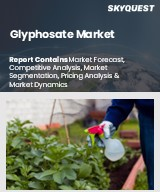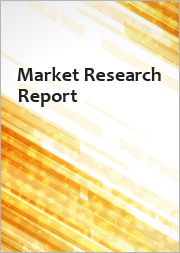
|
시장보고서
상품코드
1789223
글리포세이트 시장 규모, 점유율, 성장 분석 : 최종사용자별, 용도별, 제제별, 유통 채널별, 작물 유형별, 지역별 - 산업 예측(2025-2032년)Glyphosate Market Size, Share, and Growth Analysis, By End User (Agriculture, Non-Agriculture), By Application (Post Emergent, Pre-Emergent), By Formulation, By Distribution Channel, By Crop Type, By Region - Industry Forecast 2025-2032 |
||||||
세계의 글리포세이트 시장 규모는 2023년에 88억 달러로 평가되며, 2024년 91억 8,000만 달러에서 2032년에는 128억 5,000만 달러로 성장하며, 예측 기간(2025-2032년)의 CAGR은 4.3%로 성장할 전망입니다.
세계 글리포세이트 시장은 정부 지원, 혁신 기술, 농업 관행의 변화 등에 힘입어 크게 성장하고 있습니다. 글리포세이트는 정밀농업에서 제초제로서 중요한 역할을 하고 있으며, 작물 수확량 증대를 위한 지속가능한 농업에 대한 관심이 높아지면서 사용량이 증가하고 있습니다. 특히 AI와 머신러닝의 기술 발전은 잡초를 감지하는 방식을 바꾸어 환경 피해를 최소화하는 정확한 글리포세이트 살포를 가능하게 하고 있습니다. 또한 지속가능한 농법으로의 전환은 농업의 생태적 발자국을 줄이려는 세계 목표에 따라 에너지 효율이 높은 기계에 적합한 글리포세이트 제제에 대한 수요를 창출하고 있습니다. 이처럼 글리포세이트 시장은 현대 농업 수요에 맞추어 지속적으로 확대되고 적응해 나갈 것으로 보입니다.
목차
서론
- 조사의 목적
- 조사 범위
- 정의
조사 방법
- 정보 조달
- 2차와 1차 데이터 방법
- 시장 규모 예측
- 시장의 전제조건과 제한
개요
- 세계 시장 전망
- 공급과 수요 동향 분석
- 부문별 기회 분석
시장 역학과 전망
- 시장 개요
- 시장 규모
- 시장 역학
- 촉진요인과 기회
- 억제요인과 과제
- Porter의 산업 분석
주요 시장 인사이트
- 주요 성공 요인
- 경쟁의 정도
- 주요 투자 기회
- 시장 에코시스템
- 시장의 매력 지수(2024년)
- PESTEL 분석
- 거시경제 지표
- 밸류체인 분석
- 가격 분석
글리포세이트 시장 규모 : 최종사용자별 & CAGR(2025-2032)
- 시장 개요
- 농업
- 비농업
- 임업
- 산업 식생 관리
- 주택과 정원
- 잔디와 관상용 식물
글리포세이트 시장 규모 : 용도별 & CAGR(2025-2032)
- 시장 개요
- 발아후
- 엽면살포
- 수확전
- 발아전
- 토양 관수
- 토양 혼화
글리포세이트 시장 규모 : 제제별 & CAGR(2025-2032)
- 시장 개요
- 액체
- 유제
- 가용성 액체
- 고체
- 테크니컬 파우더
- 수분산성 과립
글리포세이트 시장 규모 : 유통 채널별 & CAGR(2025-2032)
- 시장 개요
- 직접 판매
- 판매 대리점
- 온라인 소매
글리포세이트 시장 규모 : 작물 유형별 & CAGR(2025-2032)
- 시장 개요
- 곡물
- 임업
- 과일과 채소
- 산업 식생 관리
- 지방 종자와 두류
- 잔디와 관상용 식물
글리포세이트 시장 규모 : 지역별 & CAGR(2025-2032)
- 북미
- 미국
- 캐나다
- 유럽
- 독일
- 스페인
- 프랑스
- 영국
- 이탈리아
- 기타 유럽 지역
- 아시아태평양
- 중국
- 인도
- 일본
- 한국
- 기타 아시아태평양
- 라틴아메리카
- 브라질
- 기타 라틴아메리카 지역
- 중동 및 아프리카
- GCC 국가
- 남아프리카공화국
- 기타 중동 및 아프리카
경쟁 정보
- 상위 5사의 비교
- 주요 기업의 시장 포지셔닝(2024년)
- 주요 시장 기업이 채택한 전략
- 최근 시장 동향
- 기업의 시장 점유율 분석(2024년)
- 주요 기업의 기업 개요
- 기업의 상세
- 제품 포트폴리오 분석
- 기업의 부문별 점유율 분석
- 매출의 전년대비 비교(2022-2024년)
주요 기업 개요
- Bayer AG(Germany)
- Syngenta AG(Switzerland)
- UPL Limited(India)
- BASF SE(Germany)
- Adama Agricultural Solutions Ltd.(Israel)
- Nufarm Ltd.(Australia)
- Corteva Agriscience(USA)
- Zhejiang Xinan Chemical Industrial Group Company, Ltd.(China)
- Nantong Jiangshan Agrochemical & Chemical, Inc.(China)
- Jiangsu Good Harvest-Weien Agrochemical Co., Ltd.(China)
- FMC Corporation(USA)
- Sumitomo Chemical Co., Ltd.(Japan)
- Helm AG(Germany)
- American Vanguard Corporation(USA)
- Hubei Sanonda Co., Ltd.(China)
- Lier Chemical Co., Ltd.(China)
- Sichuan Leshan Fuhua Tongda Agro Chemical Technology Co., Ltd.(China)
- King Quenson Industry Group(China)
- Excel Crop Care Limited(India)
- PI Industries Ltd.(India)
결론과 제안
KSA 25.08.20Global Glyphosate Market size was valued at USD 8.8 billion in 2023 and is poised to grow from USD 9.18 billion in 2024 to USD 12.85 billion by 2032, growing at a CAGR of 4.3% during the forecast period (2025-2032).
The global glyphosate market is experiencing significant growth, propelled by government support, innovative technologies, and changing agricultural practices. As glyphosate plays a vital role as a herbicide in precision farming, its usage is enhanced by a growing focus on sustainable agriculture aimed at improving crop yields. Technological advancements, particularly in AI and machine learning, have transformed weed detection, allowing for precise glyphosate applications that minimize environmental harm. Furthermore, the shift towards sustainable practices is generating demand for glyphosate formulations compatible with energy-efficient machinery, aligning with global goals to reduce agriculture's ecological footprint. This convergence of factors positions the glyphosate market for continued expansion and adaptation in line with modern agricultural demands.
Top-down and bottom-up approaches were used to estimate and validate the size of the Global Glyphosate market and to estimate the size of various other dependent submarkets. The research methodology used to estimate the market size includes the following details: The key players in the market were identified through secondary research, and their market shares in the respective regions were determined through primary and secondary research. This entire procedure includes the study of the annual and financial reports of the top market players and extensive interviews for key insights from industry leaders such as CEOs, VPs, directors, and marketing executives. All percentage shares split, and breakdowns were determined using secondary sources and verified through Primary sources. All possible parameters that affect the markets covered in this research study have been accounted for, viewed in extensive detail, verified through primary research, and analyzed to get the final quantitative and qualitative data.
Global Glyphosate Market Segments Analysis
Global Glyphosate Market is segmented by End User, Application, Formulation, Distribution Channel, Crop Type and region. Based on End User, the market is segmented into Agriculture and Non-Agriculture. Based on Application, the market is segmented into Post Emergent and Pre-Emergent. Based on Formulation, the market is segmented into Liquid and Solid. Based on Distribution Channel, the market is segmented into Direct Sales, Distributors and Online Retail. Based on Crop Type, the market is segmented into Cereals & Grains, Forestry, Fruits & Vegetables, Industrial Vegetation Management, Oilseeds & Pulses and Turf & Ornamentals. Based on region, the market is segmented into North America, Europe, Asia Pacific, Latin America and Middle East & Africa.
Driver of the Global Glyphosate Market
The rising cultivation of herbicide-tolerant (HT) and genetically modified (GM) crops, particularly glyphosate-resistant varieties like soybeans, corn, and cotton, significantly contributes to the growing demand for glyphosate. These HT crops enable efficient weed management through a single, potent application, thereby minimizing labor requirements and enhancing agricultural yields, making them popular among farmers. Regions where glyphosate usage is already prevalent, such as North America, Brazil, and Argentina, have seen substantial increases in market penetration. As more countries approve HT crop varieties, the glyphosate market is expected to expand further into new territories and developing agricultural economies.
Restraints in the Global Glyphosate Market
Increasing global apprehension regarding the environmental and health impacts of glyphosate, especially concerning soil degradation, a decline in biodiversity, and potential carcinogenic effects, has led to stricter regulations and outright bans in several countries. Nations are reevaluating their stance on glyphosate usage, as these mounting restrictions pose significant challenges for the glyphosate market. The trend of governments leaning towards more environmentally friendly herbicide alternatives is gaining momentum, contributing to the shrinking acceptance of glyphosate products. As a result, the industry faces mounting pressure to innovate and adapt in order to comply with these evolving regulatory landscapes and consumer preferences for sustainable practices.
Market Trends of the Global Glyphosate Market
The global glyphosate market is witnessing a notable shift towards environmentally friendly and low-residue formulations, driven by increasing regulatory scrutiny and heightened consumer awareness regarding ecological sustainability. This trend has prompted manufacturers to innovate with biodegradable products and advanced micro-dosing technologies, which not only maintain glyphosate's effectiveness in weed management but also align with sustainable agricultural practices. By prioritizing reduced environmental impact and safety, these developments not only cater to market demands but also enhance the reputation of glyphosate as a viable option for modern farming, ultimately fostering a more sustainable agricultural landscape globally.
Table of Contents
Introduction
- Objectives of the Study
- Scope of the Report
- Definitions
Research Methodology
- Information Procurement
- Secondary & Primary Data Methods
- Market Size Estimation
- Market Assumptions & Limitations
Executive Summary
- Global Market Outlook
- Supply & Demand Trend Analysis
- Segmental Opportunity Analysis
Market Dynamics & Outlook
- Market Overview
- Market Size
- Market Dynamics
- Drivers & Opportunities
- Restraints & Challenges
- Porters Analysis
- Competitive rivalry
- Threat of substitute
- Bargaining power of buyers
- Threat of new entrants
- Bargaining power of suppliers
Key Market Insights
- Key Success Factors
- Degree of Competition
- Top Investment Pockets
- Market Ecosystem
- Market Attractiveness Index, 2024
- PESTEL Analysis
- Macro-Economic Indicators
- Value Chain Analysis
- Pricing Analysis
Global Glyphosate Market Size by End User & CAGR (2025-2032)
- Market Overview
- Agriculture
- Non-Agriculture
- Forestry
- Industrial Vegetation Management
- Residential & Garden
- Turf & Ornamentals
Global Glyphosate Market Size by Application & CAGR (2025-2032)
- Market Overview
- Post Emergent
- Foliar Spray
- Pre-Plant
- Pre-Emergent
- Soil Drench
- Soil Incorporation
Global Glyphosate Market Size by Formulation & CAGR (2025-2032)
- Market Overview
- Liquid
- Emulsifiable Concentrate
- Soluble Liquid
- Solid
- Technical Powder
- Water Dispersible Granules
Global Glyphosate Market Size by Distribution Channel & CAGR (2025-2032)
- Market Overview
- Direct Sales
- Distributors
- Online Retail
Global Glyphosate Market Size by Crop Type & CAGR (2025-2032)
- Market Overview
- Cereals & Grains
- Forestry
- Fruits & Vegetables
- Industrial Vegetation Management
- Oilseeds & Pulses
- Turf & Ornamentals
Global Glyphosate Market Size & CAGR (2025-2032)
- North America (End User, Application, Formulation, Distribution Channel, Crop Type)
- US
- Canada
- Europe (End User, Application, Formulation, Distribution Channel, Crop Type)
- Germany
- Spain
- France
- UK
- Italy
- Rest of Europe
- Asia Pacific (End User, Application, Formulation, Distribution Channel, Crop Type)
- China
- India
- Japan
- South Korea
- Rest of Asia-Pacific
- Latin America (End User, Application, Formulation, Distribution Channel, Crop Type)
- Brazil
- Rest of Latin America
- Middle East & Africa (End User, Application, Formulation, Distribution Channel, Crop Type)
- GCC Countries
- South Africa
- Rest of Middle East & Africa
Competitive Intelligence
- Top 5 Player Comparison
- Market Positioning of Key Players, 2024
- Strategies Adopted by Key Market Players
- Recent Developments in the Market
- Company Market Share Analysis, 2024
- Company Profiles of All Key Players
- Company Details
- Product Portfolio Analysis
- Company's Segmental Share Analysis
- Revenue Y-O-Y Comparison (2022-2024)
Key Company Profiles
- Bayer AG (Germany)
- Company Overview
- Business Segment Overview
- Financial Updates
- Key Developments
- Syngenta AG (Switzerland)
- Company Overview
- Business Segment Overview
- Financial Updates
- Key Developments
- UPL Limited (India)
- Company Overview
- Business Segment Overview
- Financial Updates
- Key Developments
- BASF SE (Germany)
- Company Overview
- Business Segment Overview
- Financial Updates
- Key Developments
- Adama Agricultural Solutions Ltd. (Israel)
- Company Overview
- Business Segment Overview
- Financial Updates
- Key Developments
- Nufarm Ltd. (Australia)
- Company Overview
- Business Segment Overview
- Financial Updates
- Key Developments
- Corteva Agriscience (USA)
- Company Overview
- Business Segment Overview
- Financial Updates
- Key Developments
- Zhejiang Xinan Chemical Industrial Group Company, Ltd. (China)
- Company Overview
- Business Segment Overview
- Financial Updates
- Key Developments
- Nantong Jiangshan Agrochemical & Chemical, Inc. (China)
- Company Overview
- Business Segment Overview
- Financial Updates
- Key Developments
- Jiangsu Good Harvest-Weien Agrochemical Co., Ltd. (China)
- Company Overview
- Business Segment Overview
- Financial Updates
- Key Developments
- FMC Corporation (USA)
- Company Overview
- Business Segment Overview
- Financial Updates
- Key Developments
- Sumitomo Chemical Co., Ltd. (Japan)
- Company Overview
- Business Segment Overview
- Financial Updates
- Key Developments
- Helm AG (Germany)
- Company Overview
- Business Segment Overview
- Financial Updates
- Key Developments
- American Vanguard Corporation (USA)
- Company Overview
- Business Segment Overview
- Financial Updates
- Key Developments
- Hubei Sanonda Co., Ltd. (China)
- Company Overview
- Business Segment Overview
- Financial Updates
- Key Developments
- Lier Chemical Co., Ltd. (China)
- Company Overview
- Business Segment Overview
- Financial Updates
- Key Developments
- Sichuan Leshan Fuhua Tongda Agro Chemical Technology Co., Ltd. (China)
- Company Overview
- Business Segment Overview
- Financial Updates
- Key Developments
- King Quenson Industry Group (China)
- Company Overview
- Business Segment Overview
- Financial Updates
- Key Developments
- Excel Crop Care Limited (India)
- Company Overview
- Business Segment Overview
- Financial Updates
- Key Developments
- PI Industries Ltd. (India)
- Company Overview
- Business Segment Overview
- Financial Updates
- Key Developments



















